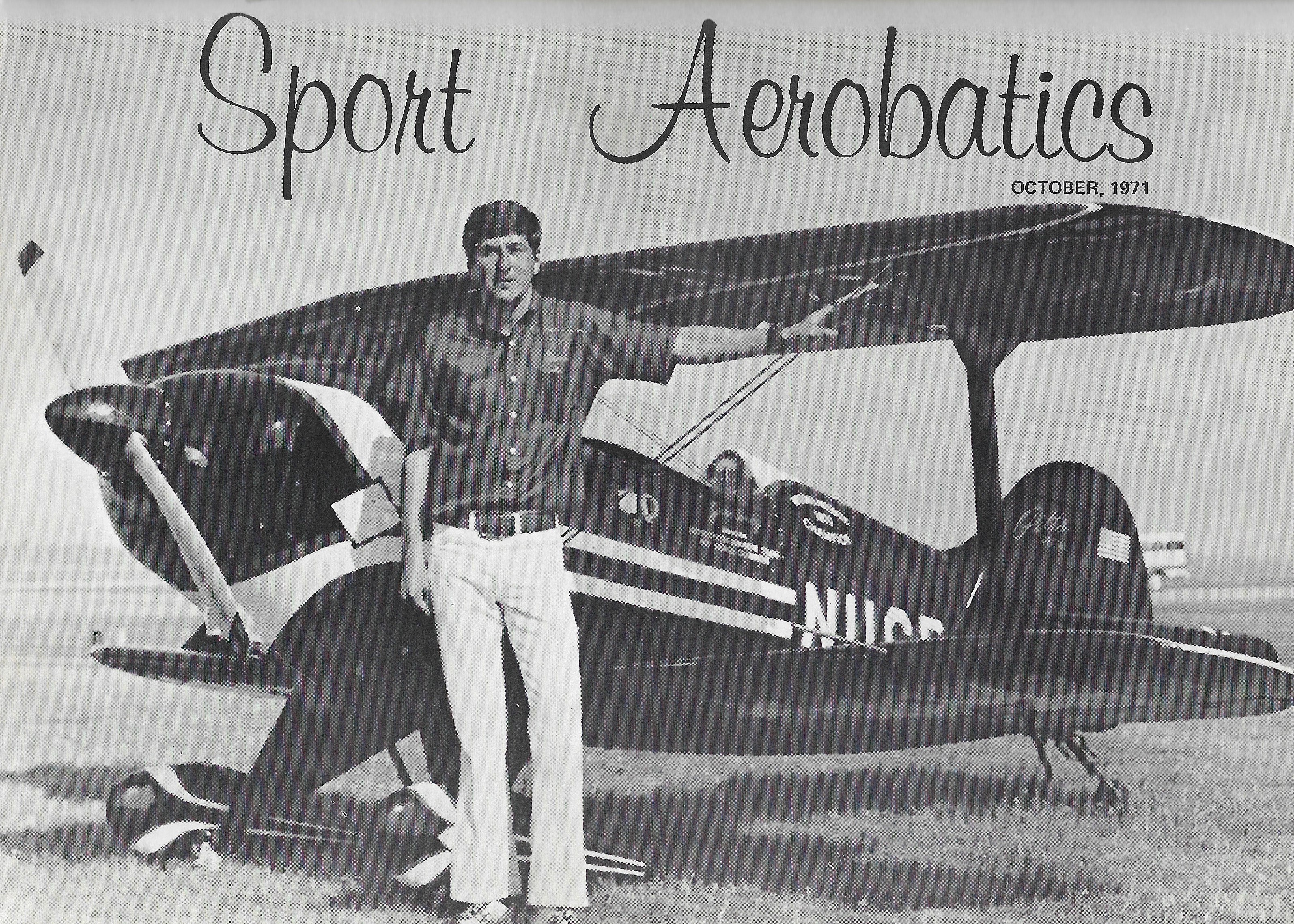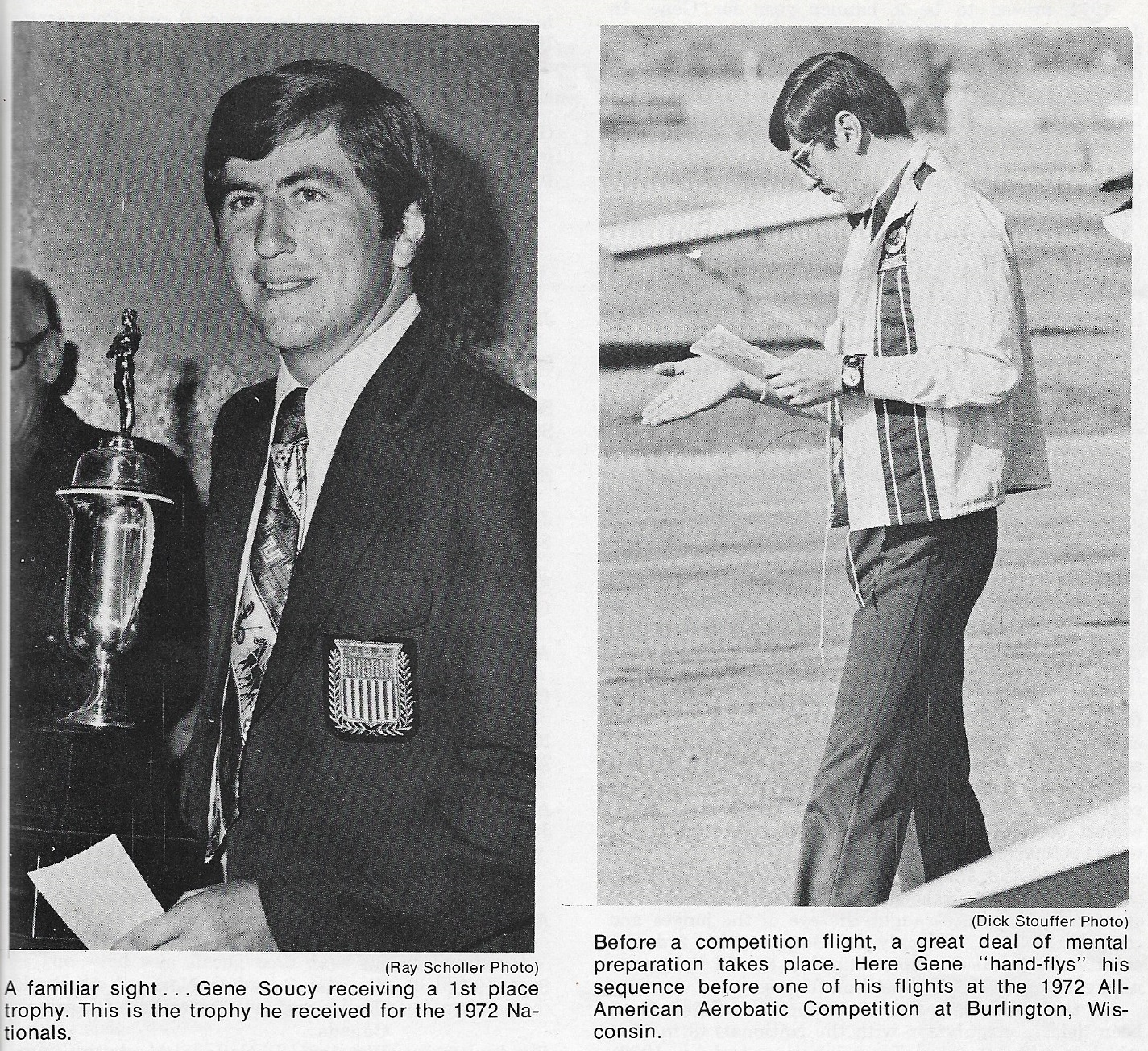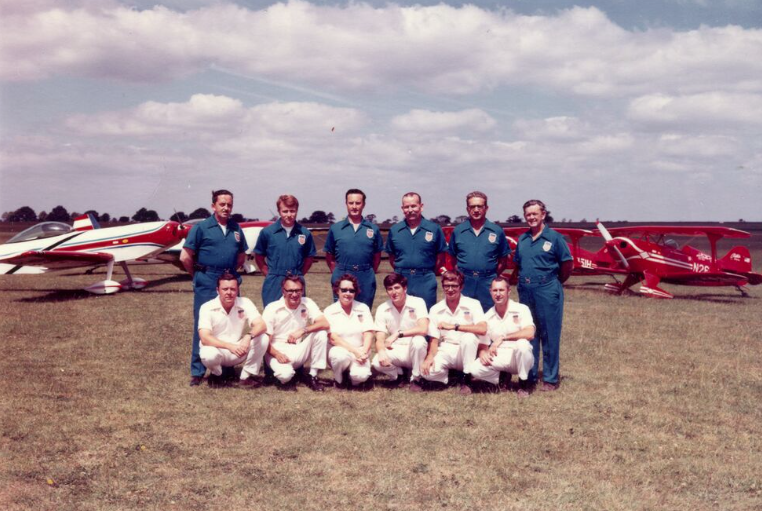Gene Soucy
The following series of articles are about Competition and Airshow great Gene Soucy from Sports Aerobatics magazine.

By Dan Clisham
Gene Soucy is one of the most celebrated names in flying. He may also be the most versatile, pairing a competition career with air show entertainment, and rising to the top in both arenas. Today, he performs multiple acts at some two dozen air shows in a typical year. His repertoire ranges from show openers through comedy and novelty flying to a spectacular nighttime act with pyrotechnics.
Gene has been a member of the 1970 and 1972 U.S. Teams at the World Aerobatic Championships. He has been a 3-time U.S. National Aerobatic Champion, and 3-time Canadian National Champion. He has won a total of four Gold and three Bronze medals in World Aerobatic Competition. His competition record includes 41 aerobatic contests, in which he finished out of the top five only six times. He has placed first 20 times, second 8 times and third 4 times.
Whether flying precision routines in his Extra 300S, performing breath taking wing walking maneuvers in his colorful “Showcat,” or helping set all-time records for team longevity and unblemished safety during his quarter century of supremacy in formation aerobatics as an Eagle, “Mr. Airshow” spends more time in the air entertaining the public than any other performer, and generates excitement wherever he appears.
Gene was one of the original “Red Devils” with IAC legends Bob Heuer and Marion Cole. Later, he formed up with Charlie Hillard and Tom Poberezny, successfully completing a 25-year run as the well-known three-man team, The Eagles. The fact that the team members did not change establishes a record that will most likely never be broken. Both the Red Devil’s and Christian Eagles aircraft are on display at EAAs AirVenture Museum.
At the age of 20 Gene Soucy earned a berth on the 1970 United States Aerobatic Team. In the 1970 World Championships in England, Gene was the youngest competitor. He finished strongly, placing sixth overall, and helped the United States Team win its first World Championship.
Since that very auspicious beginning Gene has gone on to gather an impressive competition record. He was the U.S. National Aerobatic Champion three consecutive years, the first pilot to ever accomplish such a feat. Gene was also a three time Canadian National Champion, and a member of two victorious world aerobatic teams. In December of 1985 Gene won the prestigious Hilton Masters of Aerobatics Championship, beating out nine other pilots, all former National Champions, representing six countries throughout the world. This feat attested to the fact that Gene is truly one of a kind aviator.
Gene began professional air show flying in 1968 and has appeared in every major air show on this continent. Among his 1,000 plus performances have been appearances in his first airplane, the Pitts Special “Butt Buster,” performances in a BD-4 home built and Bellanca Decathalon, thrilling comedy routines in the Piper Cub and Cessna 150, and of course his outstanding formation performances with teammates Tom Poberezny and Charlie Hillard as the most experienced and proficient formation pilots in the history of exhibition flying.
In 1988 Gene began developing a new air show act – the “Showcat”. He extensively modified a Grumman Ag Cat, a biplane normally used in crop spraying. The new “Show Cat” is fully aerobatic and is equipped with a five-point smoke system for visual effect, a wing stand for a wing walking act, and a pyrotechnic system for a night air show routine.
Soucy’s “Showcat” was modified by Jim Swick at the Swick Aircraft facility in McKinney, Texas. The six-month project entailed a complete renovation of the former crop sprayer. The total aerodynamic cleanup improved cross-country cruising speed from 90 mph to 130 mph. The combination of the Showcat’s light wing loading and high lift airfoil section provide the perfect slow speed performance for the wing walking air show Gene performs. In the air show configuration, the Showcat still operates 1,500 pounds below the maximum weight it was flown at in the crop duster configuration with a full load of chemical.
Gene had long been an advocate of a free style event flying high profile air show stars. He felt his plan, dubbed SKY STARS, would fill a need with the North American public for a competition event that could be enjoyed by air show spectators. The concept was eventually given sanction as the Championship Air Show Pilots Association (CASPA).
In a CASPA event the contest was judged by spectators chosen at random from the audience, who were briefed by Champion Clint McHenry. The competition included head to head or “duel in the sky” flying and compulsory maneuvers. The judges scores were based on the excitement and entertainment levels of each performer. It was quite a success.
Gene has filled roles in the movie industry as well. His film credits include:
Pancho Barnes Story Fokker tri-plane, Rose Parakeet, Tiger Moth
Aces/Iron Eagle II Soko Galb Jet, Japanese Zero Replica (AT-6 with a P&W 1830 engine)
Frankie’s Starlight Grumman Ag Cat
Cloud Dancer Pitts Special
In addition to his multi-faceted air show career, Gene is presently flying as a DC-9 Captain for a major U.S. airline. Gene is also the owner of the “Fly-By Café” located in the terminal building at the St. Augustine (Florida) airport. The café and bar overlook the airport from the second story and have an air show motif. The St. Augustine airport, due to his airplane, is called “Extraville.”
Normally professional air show pilots and competition pilots do not cross over into each other’s fields of endeavor. To be at the top of both at the same time is unparalleled.
AWARDS
-
National Advanced Aerobatic Champion (1969)
-
3-Time United States National Aerobatic Champion (1970, 1971, 1972)
-
3-Time Canadian National Aerobatic Champion (1970, 1971, 1972)
-
Clifford L. Henderson Achievement Award
-
J.R. Wiedekind achievement Award
-
Embry Riddle Crystal Eagle Award for Lifetime Achievement
-
Bill Adams Showmanship Award
-
Hilton Masters of Aerobatics Championship (1985)
-
Bill Barber Award for Showmanship (with Eagle Team)
-
Runner Up – art Scholl showmanship Award
-
Gold Medalist, U.S. National Aerobatic Championships, Unkown compulsory (1995)
-
FAI Achievement Award (1996 with Eagle Team)
-
Bill Barber Award for Showmanship (1997, with Teresa Stokes)
-
Rolly Cole Memorial Award (1997)
-
“Fond du Lac Cup” Winner (1997)
-
International Council of Air Shows (ICAS) Sword of Excellence Award (1998)
INVITATIONALS AND TEAM MEMGERSHIPS
-
Member, U.S. Team, World Aerobatic Championship (1970, England)
-
Member, U.S. Team, World Aerobatic Championship (1972, France)
-
25 years with The Eagles, America’s longest flying tema in aerobatics
-
1996 entrant in FAI’s World Grand Prix of Aerobatics
-
1998 entrant in FAI’s World Grand Prix of Aerobatics
The following article appeared in the March 1995 issue of Sport Aerobatics. It was a reissue of an article from December, 1972.
The Upside Down World of Gene Soucy

By Tom Poberezny
Aerobatic Club of America Newsletter, October, 1970
“Gene Soucy, the Dixie Flash, came to win and did. On Saturday, October 17, this young man from the ‘blue grass’ belt of Louisville, Kentucky stole the thunder from the veterans and new comers alike with his near flawless precision and flew on to his first National Aerobatic Championship.”
Sport Aviation November, 1971:
“Gene Soucy, Wichita, Kansas, headed the list of winners at the 1971 National Aerobatic Championships, held at Oak Grove Airport, Ft. Worth, Texas. Gene, chief pilot for the Bede Aircraft Company, became the first competitor to win the National Title two years in a row under the present rules.”
Sport Aviation, November 1972
“The 1972 National Aerobatic Championships were held at a new site, but the results were the same old story…Soucy. Twenty-four year old Gene Soucy of Wichita, Kansas won his 3rd consecutive National Aerobatic Championship, leading a tough field of eleven competitors from the start.”
Sport Aviation, November 1973
I’ll let you guess the results for the 1973 National Aerobatic Championships, but based upon past results, I have a good idea what your answer would be. Gene Soucy has not only won an unprecedented three National Aerobatic Championships, but in doing so he has been the youngest competitor each of those three years. This blend of youth, experience and a winning attitude can only make him the favorite for many years to come.
Gene started his aviation career in June of 1962 at age 14, when he soloed a Schweizer 222 glider. I am sure that whoever checked him out at the time didn’t realize that he was working with a future National Aerobatic Champion and U.S. World Champion Aerobatic Team member.
Gene’s aerobatic flying got its start in July of 1967 when he flew a Pitts Special for the first time. The airplane, owned by his father, the late L. Paul Soucy, won the best Pitts Award at the 1967 EAA Convention. It had a 180 hp Lycoming engine, with two ailerons on the standard M-6 airfoil. Gene entered his first contest at the Antique Airplane Association meet in Ottumwa, Iowa. He placed 2nd in the novice class.
A few more contests and a large number of airshows saw him graduate to a brand new 180 hp, 4 aileron Pitts. This new piece of equipment provided Gene with all the tools needed to become a National and World Champion.
Gene’s first contest in his new mount was the Unlimited Competition of the 1969 EAA Aerobatic Championships. This contest was held at Harvard, Illinois in conjunction with the 1969 EAA International Convention at nearby Rockford. Battling a strong cross-wind, he out - distanced a tough field of competitors to win his first Unlimited Competition.
Armed with this important victory, Gene started pointing for the 1969 National Aerobatic Championships. But a fateful mistake – causing him to land early due to lack of fuel during one of his flights – placed him 10th overall in his quest for a National Championship.
Undaunted, Gene started preparing for the fly-offs for the 1970 U.S. Aerobatic Team which were to be held in April, 1970. His hard work paid off, as he became a member of the 1970 U.S. Team.

The 1970 World Aerobatic Championships, held in Hullavington, England, proved to be a real milestone for aerobatics in the United States. The U.S. Aerobatic Team, in winning the 1970 World Championship, became the first Free World country to do so. Gene played an important part in this victory.
Returning to the U.S. in July, 1970, Gene added the EAA-IAC Aerobatic Title and Canadian National achievements. This provided the needed momentum for him to win his first National Aerobatic in October, 1970.
1971 proved to be a banner year for Gene. In January, he joined the Bede Aircraft Company as a Flight Demonstration and Test Pilot. In addition to flying a number of airshows, he won the EAA-IAC Title for the third consecutive year, the Canadian Title for the second time and the U.S. Nationals, also for the second time. His National Championship victory convinced U.S. Team selectors of Gene’s ability to lead this country in the 1972 World Aerobatic Championship.
Those Championships are now history. The 1972 U.S. Aerobatic Team won its second consecutive World Team Title. Mary Gaffaney won the Women’s World Aerobatic Title and Charlie Hillard took top Men’s Honors. Though Gene didn’t win, he was a very dominant factor in these championships. He led the Men’s Competition after the first two flights, winning two gold medals. After three flights, Gene trailed Charlie in the overall standings by a scant.7 of a point! The final results showed Alexi Pimenov of Russia and Gene trailing Charlie by a very small margin.
The 1972 Nationals provided Gene with two exceptionally tough challenges. First, as two-time defending National Champion, everyone would be gunning for him. To win a title of any kind is tough enough, but to defend it is even harder yet! There are always the pressures of meeting the expectations accorded to a Champion.
Secondly, Gene would be defending his title against the 1972 World Aerobatic Champion. That’s a tall order for anybody!
Gene revised his competition sequence especially for the Nationals. He felt that in order to win, his world competition sequence included such spectacular maneuvers as a knife edge-to knife edge snap, ¾ outside snap from the knife edge position, an upward vertical inside snap sandwiched between quarter rolls and a 1-1/2 inside downward vertical snap.
He used the entire competition box, flying almost as much on the y-axis as he did on the x-axis. This spectacular sequence caught the eye of the judges and competitors alike. Not only did Gene win his 3rd consecutive National Championship, but he did it by winning each of the four competition flights.
In the last two years, 12 competition flights have been held in conjunction with the Nationals (8 in 1971 which included the U.S. Team selections and 4 in 1972). Of these 12, Gene Soucy has won 11 of them. This is what you call consistency, which is the mark of a true champion.
Gene is now in the process of giving his hard working Pitts a good once-over. He has completely uncovered the airplane, and has given it a very thorough inspection. 700 plus aerobatic hours can be quite fatiguing on parts (not to mention the pilot). The airplane will be recovered in January, with the possibility of a new paint scheme to follow.
And what does 1973 have in store for Gene Soucy? He will again be flying in a number of airshows and aerobatic contests across the country. This will prepare him for defense of his National Aerobatic Title. The 1973 Nationals are important to Gene in two ways. First, he wants to win an unprecedented 4th consecutive National Championship. But even more important, the 1973 Nationals will also determine the members of the 1974 U.S. Aerobatic Team. This is the important stepping stone for the one goal that still eludes Gene – The Absolute Men’s World Aerobatic Championship. You can be assured, he won’t give up until he has it.

